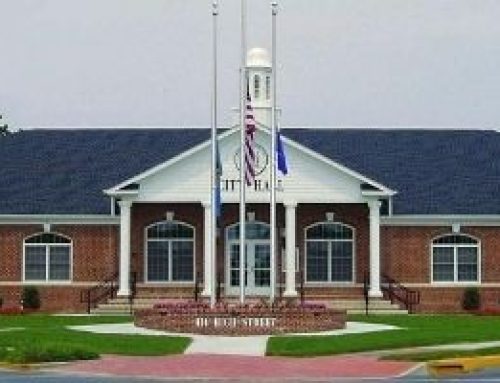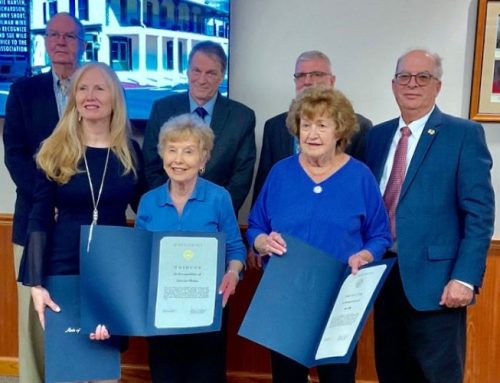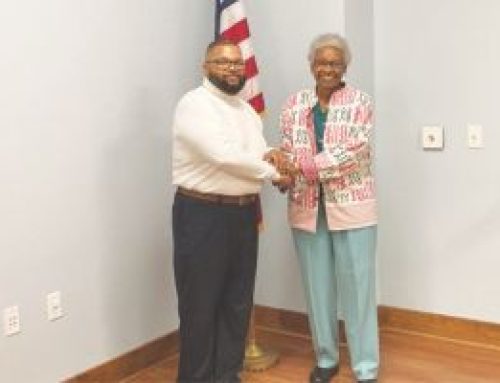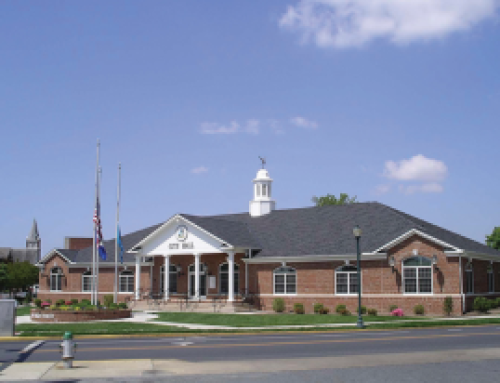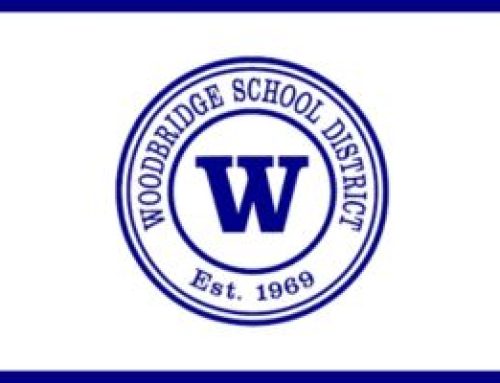Three men are vying for two seats on the Seaford City Council: incumbent Dan Henderson and newcomers Jose Santos and Alan Cranston. Following is brief biographical information on each candidate, and their answers to questions asked by the Seaford Star.

Alan Cranston
Alan Cranston is a native of Seaford and graduated from Seaford High School in 1998. After a career in information technology, he is the owner of Every Fiber Coffee Company in downtown Seaford. He is chairman of Seaford Tomorrow, focused on bringing business and events to the downtown.
Q – What prompted you to run for city council?
After being involved with downtown and investing everything I have into opening a business in Seaford, I felt the city needed more business-minded people involved in the direction of the city. After spending nearly two years working through acquiring the property and opening the business, my experience was not pleasant, to put it nicely. The city shouldn’t be the roadblock in opening businesses and growing the community. It should be the support system for business owners, investors, citizens, etc. Seaford cannot afford to turn away legitimate business prospects. Seaford cannot move forward positively without a business model that is inclusive and respectful of other cultures.
Q – Do you feel that the city of Seaford made the right decision in transforming the 911 dispatch center into a call center?
I was a member of the committee to save the center. Unfortunately, everything we did was in vain, as the recommendation agreed upon by the committee was not what was given to the council. The mayor did not have any intention in saving the center, and the city council approved a “replacement” to the 911 center without discussion on the cost. The bottom line was we were never short money to run the 911 center; it was closed for political gain. If we have the money to operate the 911 alternative, then we could have fully funded the 911 center without having to cut any essential service. The citizens of Seaford spoke loudly in support of saving the call center, and the city administration ignored the concerns and wishes of the citizenry.
As a business owner I look at the practical aspects of things, the dollars and cents, and there were and are several places in the budget where we can do things differently to save half a million dollars a year or more. That money can go to fund our police department, maintain our buildings better, even increase pay to the employees. I am willing to discuss this information with the Seaford citizens, since the current administration summarily rejected it.
Q– Do you feel that the city is on a good economic footing?
I feel the city is on a spending spree that is unsustainable without increased revenue. This results in one of two things: cutting of services (like was done with the 911 center) or increasing revenue streams. The city has untapped opportunities that would not only add revenue but add job opportunities for the community. By doing so we would be more self-sufficient and be better able to weather storms like we are currently experiencing with COVID-19.
Q – Are you satisfied with the growth the city has seen in its downtown?
I have invested everything I have in bringing back our wonderful downtown district. Along with other investors, I have put heart and soul into the belief that we can create something great here and still honor the positive aspects of our past. Unfortunately, the city is not the catalyst but the roadblock. Projects and ideas are met with considerable resistance, even ideas that have potential to generate significant revenue for the city.
Q – The city is installing infrastructure along U.S. 13 and near the Ross Business Park in the hopes that businesses will come in. Do you think that that is a good idea?
I don’t believe we have a plan or a clear vision of what we are trying to accomplish with this. What do we want, what is the vision, what do we want Seaford to be? I don’t believe this is a “if we build it they will come” scenario. We need an understanding as to what business or industry we are trying to attract and make steps to achieve that.
Q – The annual Nanticoke River report card, issued by the Nanticoke Watershed Alliance last year, gave the river a grade of C+, down from the previous year’s B-. Do you feel that the city is doing all it can to ensure the health of the river and its watershed?
I believe more can always be done, but I feel the new partnership with the Chesapeake Conservancy is a step in the right direction. I feel they have a handle on what additional steps need to take place and I hope the city follows those recommendations.
Q – How do you feel city government is functioning?
I feel traditional communication has been a one-way street from the city government. Being “heard” was not as easy as it should be. I do believe it has improved with efforts for transparency in governance made by Councilman James King in the past few years, but more needs to happen. I feel the city leadership needs to be more proactive in the groups that are the heart and soul of the town. Hearing from the “boots on the ground” helps the leadership make better, more community-inclusive decisions. Having better communication in place like this may have prevented the 911 center issue and others from occurring.
Q – Would you like to see some form of public commentary returned to city council meetings? If so, in what form?
I feel sub-committees need to be created with community leaders and community organizations that can relay the voice of the people directly to the council. Knowing “where we are as a town” would help the leadership better understand the needs of the people and recognize their input as integral to the process of decision-making for the city going forward.
Q – What do you like about Seaford?
Seaford is my home, it’s where I grew up. I’m a third-generation business owner. My family has invested in this community for decades on end. I love this town and the people in it. I love the connections we have as a community and how everyone looks out for each other. Seeing how passionate people are about “Being Seaford” is amazing. There is so much pride — that’s what I love about this town.
Q – What aspects of Seaford would you like to see changed?
We need a compass! We need direction! For more than 50 years, Seaford was a DuPont community. When DuPont left, our identity became “we used to be DuPont.” Where do we go from here? What do we want Seaford to be? There are people here ready to take action, if true and genuine leadership is presented. There is a near total lack of recognition of the Nanticoke River’s importance toward the foundation of Seaford, and a total lack of effort to promote tourism efforts involving the Nanticoke River as the last community on the river that is reachable by boats as well as larger vessels. Seaford is a community that can stand on its own merits and more than hold its own, historically and environmentally speaking. The current administration has not embraced this. If elected, I will partner in changing that. Together, the citizens of Seaford and their elected representation, representation that truly represents the will, voice and desires of their constituents, can move forward into the future with hope and confidence.

Jose Santos
California native Jose Santos moved with his family to Seaford when he was 14. He graduated from Seaford High in 2013 and has a degree in biology from the University of Delaware.
Santos is a real estate agent with Century 21 Home Team Realty, Seaford. He is on the city’s Planning and Zoning Commission and on the board of directors of the Seaford District Library.
Q – What prompted you to run for city council?
If you were to plot the location of where the mayor, city council members and representatives have lived, you would see that they are disproportionately in Western Seaford. I believe it is important that those representing Seaford represent the whole city and have an understanding of the issues important to residents on both sides of the train tracks. I first lived on Market Street right in front of city hall. Then I purchased a house on the corner of Poplar Street and Market Street when I was 19 years old, after years of hard work. I saw our elected leaders go in and out of city hall, always thinking that they had our interest at heart but all the while observing very little change. I felt invisible and I knew that I wasn’t alone. I was involved in the 911 call center committee, but I had the impression that the choice to dismantle it was already made before we were invoked, in spite of the majority of the constituents of Seaford condemning the idea.
Q – Do you feel that the city of Seaford made the right decision in transforming the 911 dispatch center into a call center?
I do not think that eliminating the dispatch center was a good idea. Previously, when I asked the dispatchers in Seaford who and what a police officer was doing on a particular street mentioned by name they answered immediately. When I asked the same question in Georgetown, the dispatcher took considerably more time to give me an answer. From asking those questions it became clear to me that there could be a difference in response time, even if it was by mere seconds. Seconds could be the difference between life and death.
The argument was that it cost too much to run but the majority of people I talked to said they were willing to pay more in taxes to keep it in place but their desires fell on deaf ears.
Q – Do you feel that the city is on a good economic footing?
This is a very interesting time to ask this question with the national economy in its current state. I believe that the city has done a good job in preparing for a time like today by increasing its reserve funds.
Q – Are you satisfied with the growth the city has seen in its downtown?
No, I am not happy. The pace is too slow. It has been years and there is very little to show for it. There have been some strides but they have been small. I believe the city needs to put pressure on the developers [who have bought property in downtown] to continue their work. It has been years and, although there are a couple new buildings up by the river, they promised much more. I want to see these results. I am grateful that the developers decided to start in Seaford as they were a spark of hope and we must do everything we can to aid them in this process and use the momentum that we have to keep moving forward.
Q – The city is installing infrastructure along U. S. 13 and near the Ross Business Park in the hopes that businesses will come in. Do you think that that is a good idea?
I think that installing infrastructure along the U. S. 13 and the Ross Business Park is a good thing to do if you are trying to attract business to our city. By having the infrastructure in place you are opening up the city and its resources to a wider range of individuals and providing them with better business opportunities.
Q – The annual Nanticoke River report card, issued by the Nanticoke Watershed Alliance last year, gave the river a grade of C+, down from the previous year’s B-. Do you feel that the city is doing all it can to ensure the health of the river and its watershed?
There is always more that can be done. Water is one of our most precious resources and we should keep our river and its watershed in good health. I have family in areas where water is scarce and we are lucky to have such a resource readily available to us.
Q – How do you feel city government is functioning?
I feel like the city government is functioning to the best of its ability despite the COVID-19 pandemic. In general, I would like to see more public involvement and hope that the city government becomes more transparent in its goals and proceedings. I think that the progress we are making by increasing public audio broadcasting is great and I wish to continue making similar efforts.
Q – Would you like to see some form of public commentary returned to city council meetings? If so, in what form?
I think it would be beneficial for all involved to have public commentary return to city council meetings. This would increase the transparency of government functioning as well as more readily allow for the voice of the residents to be heard. I think it is critical to involve our constituents as their voices may give us additional ideas and shed some light upon their vision for the city.
Q – What do you like about Seaford?
I particularly like Seaford’s location close to the beaches and several cities and the fact that the city has many resources such as its own hospital and a river. I also have a deep appreciation for the city’s rich history and know we can have just as rich a future. Seaford’s greatest potential has not been achieved yet and I wish to give our future sons and daughters a brighter city to live in.
Q – What aspects of Seaford would you like to see changed?
I have several ideas for the city, including creating a cleaner and safer city, fostering pride for our schools, and crafting a welcoming town for those that visit. I believe that our city and residents would benefit from more sustainability initiatives, including an incentive for homeowners to install solar panels and to begin transitioning to clean energy. I think that by involving the youth, we can develop a sense of pride in our city that transcends age. Lastly, I would like to see small changes made to the police force in order to reduce the hostility that residents feel toward officers. I would also like to support Seaford’s Police Department by not cutting funding that is necessary for them to serve and protect one of the largest cities in Sussex County.

Dan Henderson
Dan Henderson is a graduate of Seaford High School, class of 1980. He is employed with Applied Equipment Solutions, Ocean City, Md. He and his wife, Karen, have one daughter, Hannah, a student at Washington College, Chestertown, Md.
Henderson was elected to the city council in 2014 and won a second term in 2017. He has served on a number of committees and is the Fire and Police Department Liaison for the city council. He is also the city’s vice-mayor and is president of the Sussex County Association of Towns.
Q – What prompted you to run for city council?
I was prompted to run for city council by the desire to give back to my neighbors through service. My desires for our city government are no different than any of us. We all want safe, efficient, and reliable delivery of public services at reasonable cost. We all want the feeling of safety and security. We all want easily accessible and affordable recreational and leisure activities. All those things are intertwined with economic development and prosperity, though. Our city government should promote opportunities for entrepreneurs to invest, grow and remain here in Seaford. This will help to assure all the above are maintained or improved upon.
Q – Do you feel that the city of Seaford made the right decision in transforming the 911 dispatch center into a call center?
Transferring 911 calls to Sussex County Emergency Operations and SusCom was ultimately the correct decision, albeit an incredibly painful one. It was the culmination of nearly six months of study and consideration of the issue. Our 911 Center required massive investments in order to achieve, and then maintain, a sustainable staffing level that met regulatory requirements, and provide proper compensation with career ladders to those highly skilled employees. With revenues, expenses and needs as they are it is not good financial stewardship to have us, the Seaford taxpayers and ratepayers, paying for two 911 services at the same time (county and city).
Q – Do you feel that the city is on a good economic footing?
Notwithstanding the recent COVID-19 crisis the City of Seaford staff and administration exhibit good financial planning and stewardship with the funds they receive. Although the city maintains statutory minimum levels of reserves it is essential we strive to increase some of them. We must rein in expenses where feasible. It is a certainty that we will need to raise capital for major improvements like wastewater treatment improvements and another electrical substation modernization in the next five to 10 years. These improvements may require the issuance of bonds. Excellent financial standing will lower the cost of these bonds, and other capital, thus lowering the burden on us all.
Q – Are you satisfied with the growth the city has seen in its downtown?
It’s exciting to see so many positive changes thus far, though there is more to be done. Thanks to several forward-thinking investors, the downtown has experienced a resurgence in the past six years. This has invigorated existing business owners downtown to reinvest as well. Our city’s investments in streetscaping and other infrastructure almost two decades ago are providing a return on investment. The inception of the Downtown Development District in 2014-2015 has leveraged public/private investments worth close to $20 million, with much more development in the pipeline. Completion of the Oyster House and Riverwalk projects will fuel continued reinvestment in the downtown area.
Our city government should also be concentrating on lowering barriers and leveling the playing field where investors are risking their valuable time and resources, be it downtown or in other parts of our city. We should also be wary of gentrification. We need to ensure that residents who already live here are not pushed to the side.
Q – The city is installing infrastructure along U.S. 13 and near the Ross Business Park in the hopes that businesses will come in. Do you think that that is a good idea?
There is clear evidence that developers require utility infrastructure to be on or adjacent to the site to even be considered for selection. A quick look at other municipalities around the Delmarva peninsula provides evidence that those who invest in infrastructure improvements reap the rewards of investment in their community (Stevensville in Maryland, Smyrna, Middletown, Milford, Laurel, etc.).
Q – The annual Nanticoke River report card, issued by the Nanticoke Watershed Alliance last year, gave the river a grade of C+, down from the previous year’s B-. Do you feel that the city is doing all it can to ensure the health of the river and its watershed?
There is some debate, even among members of the Alliance, as to the reasons for the slip in this year’s rating. Some attribute it to increased development and sediment runoff. Others attribute it to increased rainfall amounts versus the previous sampling period. I am convinced it is a combination of both.
Even so, the city of Seaford, in cooperation with DNREC and U.S. EPA, promotes best practices and stringent compliance to regulations regarding stormwater management, erosion control and riverfront construction. The city itself uses practices recommended by the Alliance, and others, such as living shoreline, rain gardens, and other structures designed to limit erosion and polluted discharges. The city has recently committed resources, and we partnered with the Delaware Soil and Water Conservation District to develop a living shoreline at Riverview Park. The city’s participation in the Seaford Charette and Phase III Watershed Improvement Plan Overview in July, 2019 is more evidence of our city government’s commitment to a cleaner Nanticoke River.
Q – How do you feel city government is functioning?
Especially in regard to their response to the COVID-19 crisis, I am amazed and encouraged by how enterprising and creative our city employees are. Ideas for increases in efficiency and cost savings across the spectrum come from entry level associates through the very top levels of administration.
Our city government has made great strides in the past few years to be more open with increased communications through social media and other electronic means. Plans are afoot for a redesigned website to make interfacing with city departments online much more user friendly. We have made, but we should continue to make, even more investments in technology to make improvements to our customer’s experience.
Q – Would you like to see some form of public commentary returned to city council meetings? If so, in what form?
I have been, and I still am, in favor of public input for the good of the city during regular council meetings. I stress an emphasis on the public good. The previous experiment was not representative of the public at large, and it was used far too often as a weapon to make personal attacks that were arguably not for the public good. The format used then needs no changes now. We just need more participants with supplications and vision for Seaford’s betterment.
Q – What do you like about Seaford?
I like that the people of this city, and its surrounding community, have a giving spirit. Whether it be our time, or our treasure, we are generous to our neighbors. We help strangers who are in need, too.
Q– What aspects of Seaford would you like to see changed?
We have neighbors among us who have needs. As a consequence, our generosity attracts strangers to us as well. In addition to serving their immediate needs of shelter and hunger we need more emphasis on breaking the cycle of poverty with empowerment, accountability and skills training. Many churches, organizations and individuals are making an impact on this issue in Seaford. Our city government should seek more ways to partner with them to increase their effectiveness.
Substance abuse is not just a local problem. It is a cultural and spiritual malaise nationally. We can work more closely with state and national departments for more resources. Actively engaging with the groups that are treating addiction, and the secondary problems caused by it will help bridge the gap of understanding. Addiction-related health issues and crime puts stress on our law enforcement and first responders, and it draws resources away from other pressing public safety and health pursuits.
I would like to see more involvement in improving neighborhood pride. Our governor has introduced anti-litter initiatives that could aid grass roots neighborhood organizations to help improve the health and appearance of our neighborhoods. We could utilize those programs to better effect.
We need to actively support existing, and seek additional, outdoor recreational and leisure activities for Seaford youth and active adults. Activities such as cycling, kayaking, basketball, skateboarding, and a host of other activities would be successful if explored and supported by the city. Some of those would naturally be private ventures, however the city could play a key role in their development.

